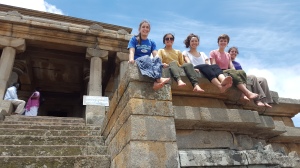11/8/2015, 1:21pm
Well I’m back in the good ‘ol PNW and have been back for a full 10 days. I discussed in an earlier post my realization that I wouldn’t be gleaning some nice neat, bow-on-top kind of lesson or knowledge from the trip, but I did do a small bit of reflective writing for Indhu and Usha. They asked us to write about three memories from the month:
- A striking new idea we had come across
- An especially inspirational moment
- A moment that was especially emotionally stirring
Here’s what I wrote (in about five minutes; don’t judge too hard):
- Thinking about individual responsibility in reading poetry or seeing art. Miss Pratibha addressed our concerns about how difficult it is to teach poetry without, as Billy Collins aptly put it, “beating [the poem] with a hose to find out what it really means.” We also were wary about reading literature and poetry written in a drastically different context than that which we are familiar with; we didn’t want, for example, to read one novel about the Nigerian/Biafran war in the 1960s (Half of a Yellow Sun by Chimamanda Ngozi Adichie) and think that we “get it” just from reading the book without really knowing a lot about the relevant context. Miss Pratibha said that art and literature should be seen as more of a gateway, an invitation for the student to explore more–find out more about the author’s life, the history of the genre, the specific events occurring around the time the poem or art piece was created–if she felt moved to do so. Some poems stir us, others don’t do much for us. Miss Pratibha encouraged us to approach art and poetry expecting to take on more responsibility than we do; responsibility to be the agents of our own learning and do investigating where we feel called to do so.
- Miss Akkai’s whole presentation was so incredibly inspirational. I loved the whole thing. Hearing about the horrible things that have happened to her and the discrimination she faces as a trans woman while seeing what an action-oriented, joyful, compassionate person she is was my favorite moment of the trip. I know that no matter what awful things come up in my life, I can remember Miss Akkai’s joy and resillience and be inspired to respond as she so miraculously has.
- Our discussion about the possibility of living a meaningful, justice-driven life without being an activist was a very important moment for me this month. This was a huge emotional relief to me after feeling so guilty and hopeless about the world, and thinking that the only way to really be a good person in it (as a person of privilege) was to be an activist, though I don’t that activism is the right fit for me. Hearing from people that I trust and respect that I can work for justice no matter what my career was a wonderfully relieving catharsis.
So these were some highlights of the month for me.
I believe the blog ends here, but the learning certainly doesn’t. I’m starting to think that it never will.

















